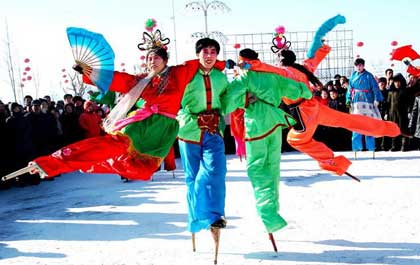Source: chinaculture.org
01-17-2008 17:27
 |
Cai Gaoqiao, or walking on stilts, is another popular traditional performance of the Spring Festival, especially in Northern China. Cai means walking on, and Gaoqiao means stilts. According to the archives, our Chinese ancestors began using stilts to help them gather fruits from trees. This practical use of stilts gradually developed into a kind of folk dance.
Gaoqiao performance requires high skills and varies in forms. Usually the performers tie two long stilts to their feet, making them higher than others when standing on stilts. On their "moving stage", they are deeply loved by masses.
Most stilts used today are made from wood. There are "double stilts" and "single stilt" performances. The double stilts are usually tied to one's shank to fully demonstrate his skill; and the single stilt is held by the performer so that he can go up and down freely. The performance can be also divided into "Wenqiao" (the civil one) and "Wuqiao" (the martial one). The former stresses appearance and amusement, while the latter emphasizes individual unique skill. Gaoqiao has now assumed strong local flavor and national color.
In Shandong Province, Gaoqiao is done at three levels, and people at the upper level stand on the shoulder of the lower ones.
In Beijing and Tianjin, performers show their high skills by jumping on one foot or going through obstacles. Some performers can even jump down from four highly-piled tables on one foot.
In Northeast China, Gaoqiao in southern Liaoning Province is the most famous. It has complete procedures and a standard form. At first, performers must "Daxiang", that is, one stands on the shoulder of another and do a yangko dance. Then they run to change queue formations. At last, they perform in groups including pair dancing, "catching butterflies", "fishing" and small local operas, etc.
Ethnic groups, when performing Gaoqiao, usually wear clothes of their own nationality. The Bouyei ethnic group has both double stilts and single one; the latter one, due to its simplicity, is especially loved by children. In "Gaoqiao Shuama" of the Bai ethnic group, performers are dressed like a horse. The "Two-Person Gaoqiao" of the Uygur ethnic group blends their local dance in it, which is new and fresh.
Scholars believe the Gaoqiao originates from the totem worship of primitive clans and the fishermen's lives along the coast. Historians have proved that the Danzhu clan in the times of Yao and Shun emperors, who took the crane as their totem, walked on stilts in their sacrificing and imitated dances of the crane. Archaeologists say some oracle-bone scriptures had images of dancing on stilts.
In the ancient geography book Shanhaijing (The Book of Mountains and Seas), there is an account of Long-Leg Kingdom. According to ancestors, the Long-Leg Kingdom was related to "walking on stilts". From the text, readers can imagine a man walking on stilts, holding a long fishing tool to catch fish in the shallow water Jingzu fishermen along the coast of Fangcheng, the Guangxi Zhuang Autonomous Region, still keep the custom of fishing this way.
Editor:Liu Fang
